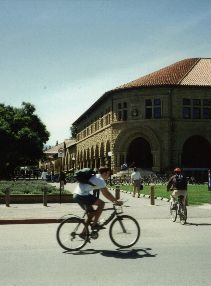|
|
  iMahal Interview Series:
iMahal Interview Series:
Joanne Martin
May 4, 2001
 iMahal:
Recently, you were awarded the Distinguished Educator Award of the Academy of Management. You were the first woman selected to receive this award, the highest educational achievement award given by the Academy. We presume that women have received similar awards in other similar Academys. Why do you think it has taken so long in the field of management?
iMahal:
Recently, you were awarded the Distinguished Educator Award of the Academy of Management. You were the first woman selected to receive this award, the highest educational achievement award given by the Academy. We presume that women have received similar awards in other similar Academys. Why do you think it has taken so long in the field of management?
 Joanne:
Change is slow. Across the US, there were very few women ahead of me in the academic ranks at other business schools when I started as an Assistant Professor in 1977. Now, however, business schools have changed.
Joanne:
Change is slow. Across the US, there were very few women ahead of me in the academic ranks at other business schools when I started as an Assistant Professor in 1977. Now, however, business schools have changed.
| | | | | |
... women are very welcome here ...
|
My field, organizational behavior, is actually one of the first to have relatively large numbers of women faculty; marketing was another. Stanford Business School now has 14 women out 87 on the tenured and tenure-line faculty.
In the U.S. most business schools have even more women on the faculty than we do. And next year 40% of Stanford's MBA class will be women -- a record. Women are very welcome here.

iMahal:
At places like the graduate business school at Stanford, people are considered successful for two things: their research and their teaching, probably in that order from what we hear. Your award from the Academy cited your "extraordinary contribution of time, talent, and compassion to the learning and development of doctoral students and junior faculty." We have two questions about that: First, does your own organization (Stanford GSB) reward this type of activity? And second, do you think this is a sign of a third measure of success -- mentoring other academics -- that will factor into the performance reviews of academics?
 Joanne:
It was great to be rewarded, by the National Academy of Management, for work with PhD students and young faculty. These aspects of teaching are also rewarded locally, and MBA teaching is definitely seen as also being very important here. Research skills at the highest levels of excellence are also absolutely essential for tenure. Most Stanford faculty would say, I think, that research is the hardest hurdle we have to clear before we can earn tenure, but without fine teaching as well, tenure cannot be earned.
Joanne:
It was great to be rewarded, by the National Academy of Management, for work with PhD students and young faculty. These aspects of teaching are also rewarded locally, and MBA teaching is definitely seen as also being very important here. Research skills at the highest levels of excellence are also absolutely essential for tenure. Most Stanford faculty would say, I think, that research is the hardest hurdle we have to clear before we can earn tenure, but without fine teaching as well, tenure cannot be earned.

iMahal:
Okay, now let's talk about Stanford University as a whole, not just the business school. Why is Stanford such a magical place in the minds of so many people? And how did this mystique grow and change over the years?
 Joanne:
First, let me talk about what has changed. Stanford used to be a regional school, serving mostly northern California, then it began to draw students from all of California, then the western US, soon the entire US, and now -- 27% of our MBAs and even more of our PhD students are international.
Joanne:
First, let me talk about what has changed. Stanford used to be a regional school, serving mostly northern California, then it began to draw students from all of California, then the western US, soon the entire US, and now -- 27% of our MBAs and even more of our PhD students are international.
 What hasn't changed is the beauty of the campus. Parts of the university still look the same as when the university was founded by Jane and Leland Stanford, in the memory of their son, Leland Junior. Many of the columned arcades and sandstone buildings with their red tile roofs have been preserved, even though their interiors have been updated. The weather is also unchanged: the air is still warm, and the nights are just cool enough to sleep comfortably even in the summer. We have incompetent meteorologists in California because their five-day weather forecasts are usually "sunny, sunny, sunny, sunny, and sunny." We call this the "weather effect" and make sure that newly admitted students, who are deciding which school to pick, visit us when the east coast of the US is still frozen.
What hasn't changed is the beauty of the campus. Parts of the university still look the same as when the university was founded by Jane and Leland Stanford, in the memory of their son, Leland Junior. Many of the columned arcades and sandstone buildings with their red tile roofs have been preserved, even though their interiors have been updated. The weather is also unchanged: the air is still warm, and the nights are just cool enough to sleep comfortably even in the summer. We have incompetent meteorologists in California because their five-day weather forecasts are usually "sunny, sunny, sunny, sunny, and sunny." We call this the "weather effect" and make sure that newly admitted students, who are deciding which school to pick, visit us when the east coast of the US is still frozen.


 

|
 |



